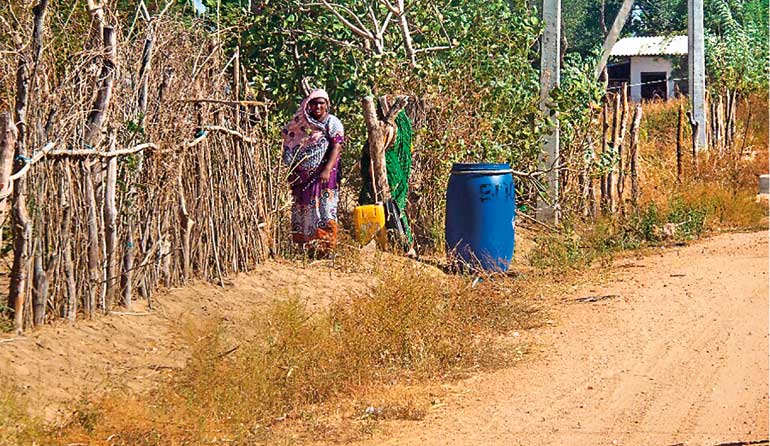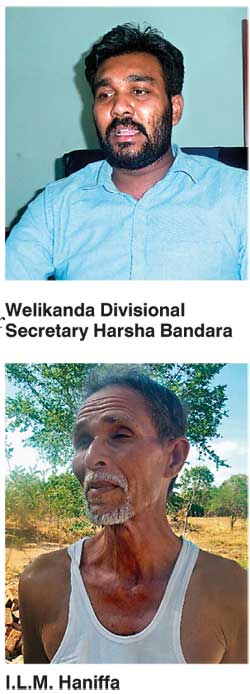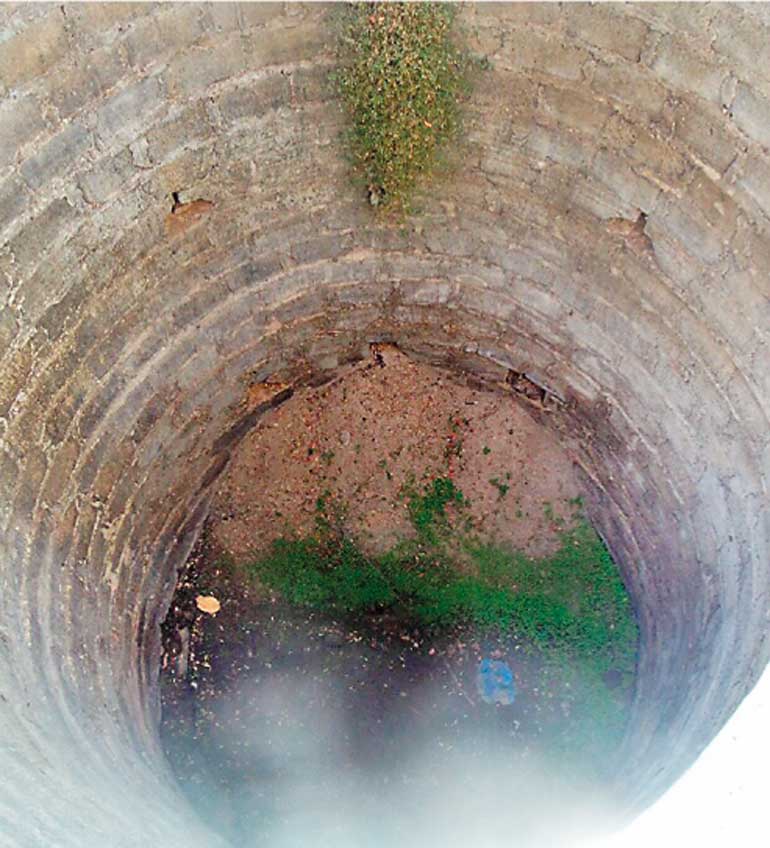Monday Mar 17, 2025
Monday Mar 17, 2025
Tuesday, 18 October 2016 00:05 - - {{hitsCtrl.values.hits}}
Text and pix by P.D. de Silva
From 1 September as many as 29,248 persons belonging to 8,527 family units in the Welikanda Divisional Secretaries area have had to quench their thirst with the ration of a few litres of water supplied by bowsers every other day after the authorities decided to conserve the water remaining in the Maduruoya reservoir for the next Maha season which should commence in early November.
An extent of 9,000 hectares are brought under paddy cultivation in Welikanda and the exact date on which the sluice gates are to be opened will be decided at the Mahaweli Water Management Committee which is to meet on 24 October.
 Waiting for the bowser
Waiting for the bowser
“Welikanda is an area which does not have ground water of its own even the 43 irrigation tanks within the area have to be fed by water released from the Maduruoya reservoir along concrete lined channels which are known as ‘Zd’ channels. But during the dry season each year the irrigation authorities are compelled to retain the water in the Maduruoya reservoir for the next cultivation season and as a result we have to provide drinking water for almost 30,000 persons belonging to approximately 8,500 family units  each day,” said Welikanda Divisional Secretary Harsha Bandara. “We have to spend a considerable amount of money to provide drinking water as some bowsers consume 25 litres of fuel for a hundred kilometre trip,” he added.
each day,” said Welikanda Divisional Secretary Harsha Bandara. “We have to spend a considerable amount of money to provide drinking water as some bowsers consume 25 litres of fuel for a hundred kilometre trip,” he added.
There are over 41,000 persons belonging to 12,200 family units living in Welikanda. According to statistics released by the Disaster Management Centre a few days ago 29,248 persons belonging to 8,527 family units in the area were faced with a severe shortage of drinking water.
“We are compelled to provide drinking water obtained from Gallella using 16 bowsers and at times they have to travel as much as 55 kilometres each way to distribute it. In addition we have to provide sufficient drinking water for 5,865 school children at 18 schools in my district,” he added. The shortage of drinking water in Welikanda should end by 2019 once the proposed water supply scheme costing Rs. 56,000 million is commissioned.
“The other problem the people encounter is wild elephants. There are more than 400 elephants that roam within my district. The elephant corridor between the Somawathy and Maduru Oya National Parks runs through Welikanda. After the war ended this corridor was blocked because the Government allocated these lands to large companies for agricultural ventures. We have taken steps to open up a one kilometre wide corridor immediately to enable the elephants to pass through unhindered,” he said, pointing out the newly-opened-up path bordered by electric fences on the road leading to the Mahawelitenna village which is about 35 kilometres from Welikanda town and almost 55 kilometres from Gallella where purified drinking water is available.
The wells in the village were bone dry. “People were settled in Mahawelitenna village in 1992,” said I.L.M. Haniffa one of the pioneer settlers. “If the authorities settle 50 families, only 10 families will remain in the village while the others go back to where they were brought from. We face this shortage of drinking water every year. Every well in the village is dry,” he added, pointing to the well in his compound.
We were lucky to see a herd of over 20 elephants come for a drink of soothing water on the far bank of the Mahawelitenna tank which was drying up fast.
 A well run dry in Mahawelitenna village
A well run dry in Mahawelitenna village
Discover Kapruka, the leading online shopping platform in Sri Lanka, where you can conveniently send Gifts and Flowers to your loved ones for any event including Valentine ’s Day. Explore a wide range of popular Shopping Categories on Kapruka, including Toys, Groceries, Electronics, Birthday Cakes, Fruits, Chocolates, Flower Bouquets, Clothing, Watches, Lingerie, Gift Sets and Jewellery. Also if you’re interested in selling with Kapruka, Partner Central by Kapruka is the best solution to start with. Moreover, through Kapruka Global Shop, you can also enjoy the convenience of purchasing products from renowned platforms like Amazon and eBay and have them delivered to Sri Lanka.
Discover Kapruka, the leading online shopping platform in Sri Lanka, where you can conveniently send Gifts and Flowers to your loved ones for any event including Valentine ’s Day. Explore a wide range of popular Shopping Categories on Kapruka, including Toys, Groceries, Electronics, Birthday Cakes, Fruits, Chocolates, Flower Bouquets, Clothing, Watches, Lingerie, Gift Sets and Jewellery. Also if you’re interested in selling with Kapruka, Partner Central by Kapruka is the best solution to start with. Moreover, through Kapruka Global Shop, you can also enjoy the convenience of purchasing products from renowned platforms like Amazon and eBay and have them delivered to Sri Lanka.